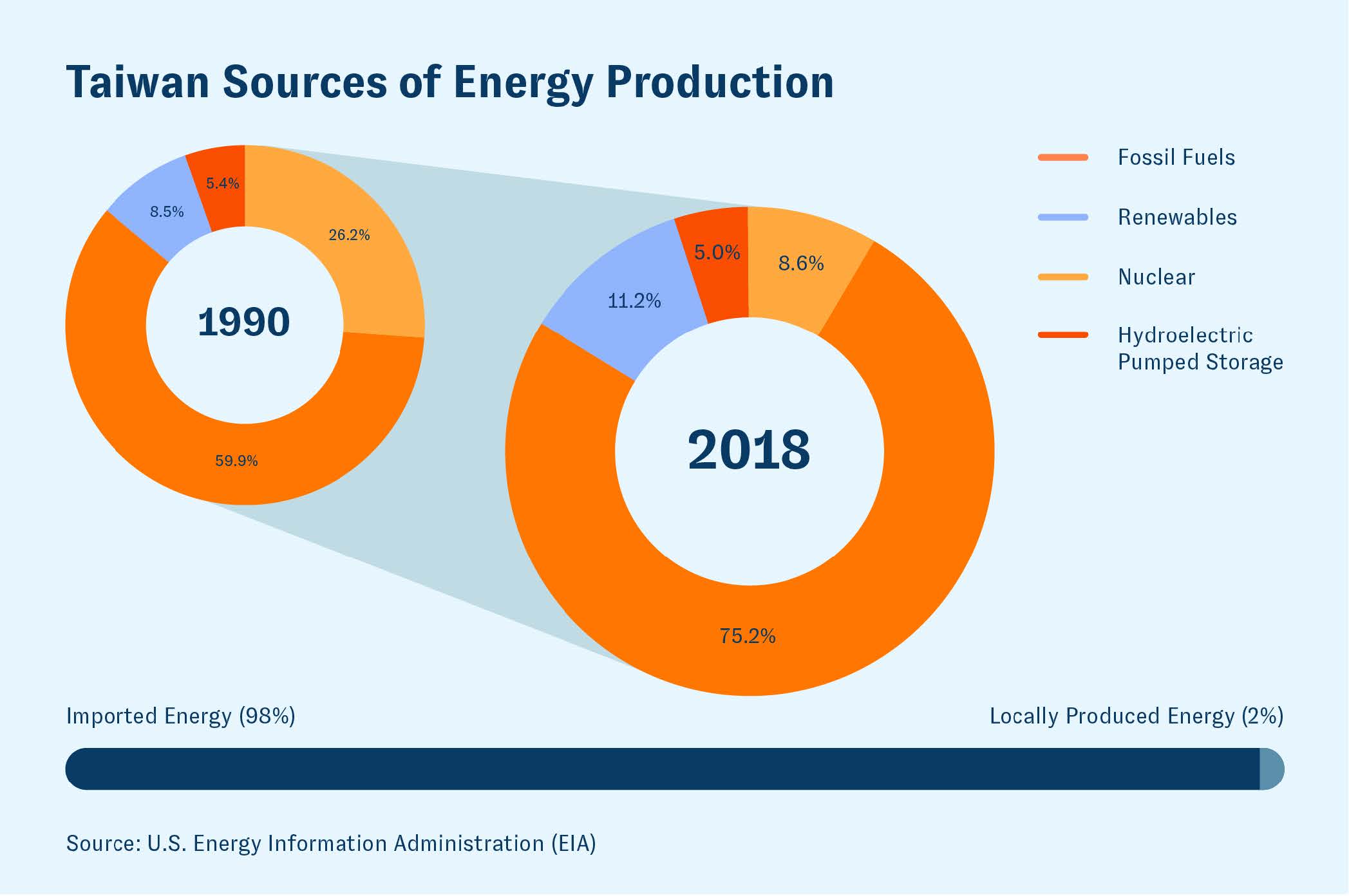Taiwan is running on empty, and importing fuel won’t fix the root problem: The island is in desperate need of its own energy supply. In 2016, domestic energy production made up only two percent of Taiwan’s total energy consumption. 98 percent of the energy supply is imported and most of it comes from fossil fuels, with 48 percent of its energy coming from coal, 29 percent from oil, and a mere 13 percent from natural gas. And while Taiwan has been shifting towards natural gas by transitioning its coastal factories to run on liquid natural gas (LNG) instead of coal, LNG is nothing more than a transition fuel; it’s a band-aid remedy for a rapidly worsening energy crisis evidenced by island-wide power outages. Moreover, the gap between power supply and power demand in Taiwan is growing at a time when the coastline is rapidly disappearing, particularly where its existing power stations are located. As a small island nation, Taiwan is poised to face devastating climate consequences in the next few years, and it needs to turn its focus toward more sustainable options.
Energy is a national security issue in Taiwan. Two of Taiwan’s largest LNG suppliers, Malaysia and Indonesia, are located in the increasingly militarized South China Sea, where rising political tensions jeopardize LNG shipping lanes. China will do whatever it takes to limit Taiwan’s international relationships, including intimidating Taiwan’s trading partners and potentially staging an attack on Taiwan’s electrical grid. Given this, Taiwan must focus on developing domestic solutions to mitigate its overreliance on foreign energy sources.
Furthermore, the Tsai Ing-Wen administration has pledged to phase out nuclear power, heretofore Taiwan’s main domestic energy source, and reach 20% renewable energy usage by 2025. But this leap is only possible with increased foreign investment in Taiwan’s most environmentally friendly resources, wind and geothermal energy. Taiwan should utilize its trade relations with Southeast Asia and its unique ability to innovate as a means of fueling its search for suitable economic partners.
Taiwan’s government has slowly begun the process of renewable investment, particularly in wind energy. This year, the first ever wind farm in Taiwan opened up six kilometers off the northwest coast. Known as Formosa 1, this “demonstration wind farm,” a joint venture between Danish, Japanese, Australian, and Taiwanese companies, provides eight megawatts of electricity, which is enough to power 128,000 Taiwanese households per year and reduce carbon emissions by 245,000 tons. The first of its kind in Asia, Formosa 1 stands as a symbol of growth and possibility in domestic energy production, so much so that funding has already been secured for a Formosa 2. Wind investment is definitely a great place to start, but Taiwan may need to look below the surface to reach the 20 percent renewable energy target by 2025.
To capitalize fully on its natural resources, Taiwan should invest in further exploration and development of geothermal energy systems. Sitting on the Pacific Ring of Fire, Taiwan has access to huge stores of underground energy. Explorations were made in the northeast corner of the island beginning as early as the 1960s, yet because the government failed to enact geothermal development policies, research was halted in favor of other energy sources. The Taiwan Geothermal Association has identified 18 areas around the island ripe for geothermal energy extraction and is actively looking for investors to fund large-scale projects. While geothermal energy can initially be expensive to develop, it is very environmentally friendly and can be implemented on a household level, making it much less prone to Chinese interference. Taking lead from other nations in the region that have already developed geothermal systems, such as the Philippines and Indonesia, Taiwan can prioritize a sustainable future over economic expediency by building geothermal extraction infrastructure.
Although LNG may be cleaner and more efficient than fossil fuels or nuclear energy, it is not a viable long-term substitute. There is a large body of research which shows that drilling for natural gas is harmful to local environments, and burning it still releases pollutants like methane into the atmosphere. For geopolitical and environmental reasons, Taiwan should focus on developing its own energy infrastructure in the most promising sectors to mitigate the effects of future energy shortages and prepare itself for the devastating effects of climate change, as the disproportionate damage to small island nations is already starting to manifest. Harnessing the power of the wind and earth will set this Asian democracy well on its way to energy stability and self-reliance.
Infographic: Minji Koo ’20 and Nathaniel Ostrer ’21
This article originally appeared in the March 2020 issue of the Brown Political Review magazine.
